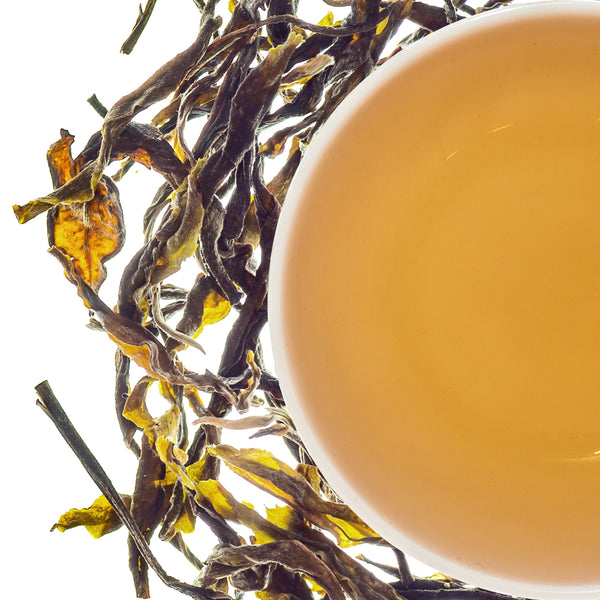-
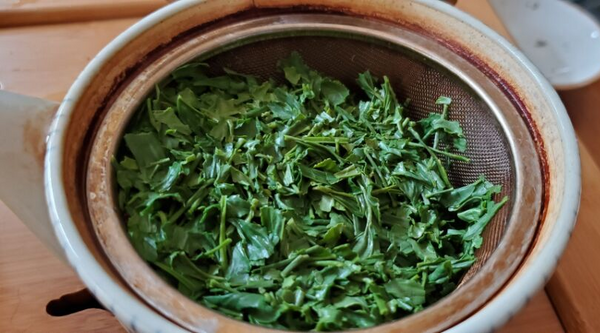
Steeped Asanoka #80
Here’s a quick compare and contrast of the three newest Japanese green tea arrivals:
Sencha #35

Each tea was steeped three times in the following manner:
10 grams of tea, 10 ounces of water
1st Steep – 1 minute, 175°f
2nd Steep – 1 minute, 175°f
3rd Steep – 1 minute, boiling water
(There’s many more ways to steep than what I did. Don’t judge me or take it as gospel. It was just my mood at the moment).
Asanoka #80 - Buy it here
This tea is my favorite of the bunch. Asanoka is the name of the cultivar. It has a long-leggy, deep emerald green appearance. The steeped leaf aroma has a slight roasted grain quality to it without being toasty. The cup is DARK and savory – a real mouthful! It has a mushroom-like quality that warms the mouth and travels to the gut well. If you don’t like it, that’s too bad, because that aftertaste is going to hang on a long time. A silky textured body fully hangs on for the second steep and only barely declines after the third. This tea will go the distance.
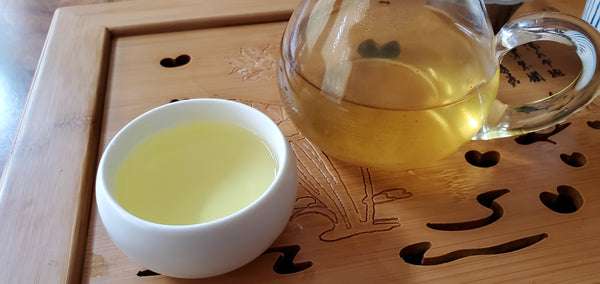
Asanoka #80 liquor
Sencha #35
This is an excellent tea for the price. It’s made of the popular Yabukita cultivar and contains mostly small particles (which is not uncommon in Japanese tea). The aroma and flavor are notably floral. It packs its punch quickly and fades to a more sweet, slippery body. Because of the small particles the second and third steep thin out quickly and the liquor turns a charming incredible-hulk opaque green. This tea is double or nothing.
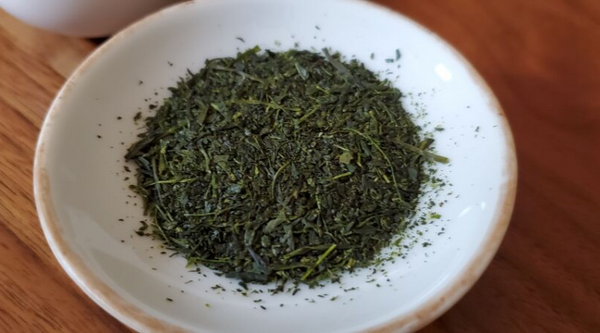 Sencha #35
Sencha #35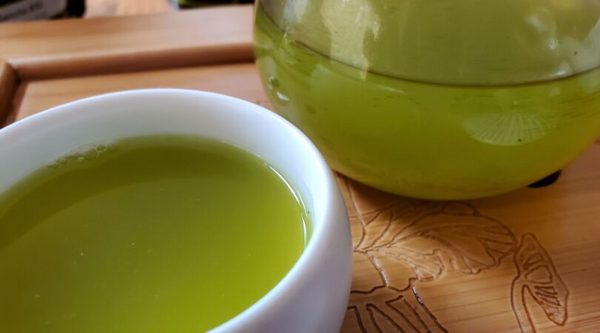
Incredible Hulk Sencha #35
88th Night Shincha - Buy it here
Classy stuff! The dry aroma is seaweed and rye. It has those deep green long leaves that produce a heavy, brothy body that reminds a Midwesterner of buttered corn. A mushroomy undertow warms up the mouth and gut, but a floral quality holds on if you breathe out your nostrils. It thins out a little for the second and third steep and starts to bring forward a melon/floral sweetness that almost wants to get sharp, but doesn’t. When you start talking about the intentions of the tea you know it’s time to hang it up. Turn off the jukebox and cut this guy off.
Shop All Japanese Green Teas

-Michael Lannier, Operations Manager
-

The Wild Tea Trees of Nan Nuo Shan
The most notable thing that morning is that it wasn’t raining. It rains a lot in Yunnan in July. Cloudy and wet are not considered good conditions for tea picking. Neither is summer (usually), but I was told they chase the weather, not the calendar, and some farmers are finally getting the weather conditions they want. As we were sitting with Ms. Wang in her tea shop, we observed evidence of this. The spring was too cold and dry. The resulting tea was muted of its potential. Her summer sheng puer, just made, was already fuller and more vital with a warm, oily character.

Hanging out in Ms. Wang’s tea shop drinking the 2019 lot of our 2018 Yiwu Sheng Puer tea
Mr. Yang Xiuhai is the maker of these teas and an acquaintance of my travel companion, Daniel. He had to leave unexpectedly before we got there, so Ms. Wang Xiyan (whom none of us had ever met), his business partner, hosted us instead. It is common to hang out, drink tea, and march off into the woods with complete strangers in China. Mr. Yang makes the tea. Ms. Wang runs the business. The shop is gorgeous, but completely comfortable. Their giant tea table had an island surrounded by water with goldfish, live plants, a Plecostomus “suckerfish” (to keep it clean), and topped with dry ice.
Buy 2018 Yiwu Sheng Puer HERE

Ms. Wang and her tea table. Without a doubt I would have dropped the cup in the water.
The next day we left Ms. Wang’s shop in Jinghong to visit the wild tea trees of Nan Nuo Shan (“shan” means “mountain”) in the Menghai area of Xishuangbanna. On the way up we made an unannounced stop (at least unannounced in English) to meet Mr. Zhao Tian, whose family owns tea fields on the mountain and used to help out Ms. Wang in her tea shop (I would piece together all this information later. At that moment and for many hours to come, I had no idea what was going on, which was typical).

Left: The King of Puer Tea Trees. Not very photogenic, but you don’t have to be at 800 years old. Right: Me & Mr. Zhao
The first stop was a visit to the “King of Puer tea trees”, an 800-year-old giant that has been “retired” and is now just here to remind us of the length of time that passes in a place like this. The fields are well taken care of with a few boardwalks and paved walkways, because in China there is such a thing as tea tourists (that would be me on this occasion).

Mr. Zhao Tian
We met a tea farmer dressed in camouflage with a small market stand in the middle of the tea fields. We drank tea, ate candy he made from the fruits of the tea plant, and tea eggs. He says that the farmers are no longer growing rice and vegetables on the mountain anymore and are going into town to buy such things. He considers this a good situation and a sign of prosperity. I bought some tea from him.

The tea farmer in camo. It is somehow not considered rude to take over a complete stranger’s tea table and drink his tea.
We then traveled to Mr. Zhao’s home in the village of Bama on the same mountain. Let’s just say the conditions are modest by American standards. A one room flat that includes the fire pit where he cooks his food, eats, sleeps, and stays out of the rain or sun. An outdoor patio-like area is attached for washing (clothes/utensils) and an Asian toilet that is not hooked up to running water. His vegetable garden is just off to the side and below this area. His tea drying and processing rooms is on the opposite side of the house. The accommodations may not be fancy, but the material from their tea field is in demand. He plans to build a new house in the village. Modern instead of traditional style, but the fire pit will stay.
Mr. Zhao cooking for us. The traditional fire pit is the most important part of the house and they will retain it even in a modern home.He cooked us a six-course lunch while we drank his tea out on the patio area. He made greens and onions from his garden, bamboo, pickled vegetables, two kinds of smoked pork, and soup. Upon learning how much I love spicy food, he insisted I take home a jar of his homemade hot pepper blend, along with some of his tea. I just met this guy this morning.

Mr. Zhao's tea fields
After lunch we hiked up (mostly vertical) into his family’s tea fields on the side of the mountain near his home. There were wild tea trees of a range of ages intermixed with pruned, terraced tea bushes for easier picking. It was all woven through a largely untouched ecosystem that will keep the plants healthy (and bite Mr. Zhao’s foot at one point).

Mr. Zhao’s mother and Ms. Wang picking tea.
His mother was out there picking tea for summer material that was still in demand. From here I could see down over the village in what for me was an exotic landscape, but for them could not be more mundane. This place is not a carefully messaged brand, it is just life – as important and regular as anywhere else. Their tea will arrive at TeaSource in late September if all goes well. A transaction that will hopefully warrant a return visit someday.
 The village of Bama as witnessed from the tea fields.
The village of Bama as witnessed from the tea fields.-Michael Lannier, Operations Manager
-
Check out Golden Buddha & Rock Oolong!
Both of these teas were made by Mr. Tang Shuang Jiang.

Mr. Tang cupping sheng puer in Xi Gui
I love the food in China (a geographical distinction from Chinese food in America). I love the seemingly infinite variety of plates that march endlessly towards your table that you communally pick from, the generous use of chili peppers, and the comfort of three constant companions; tea, rice, and some kind of savory, brothy soup. Making that broth takes time and patience rarely found in American kitchens.
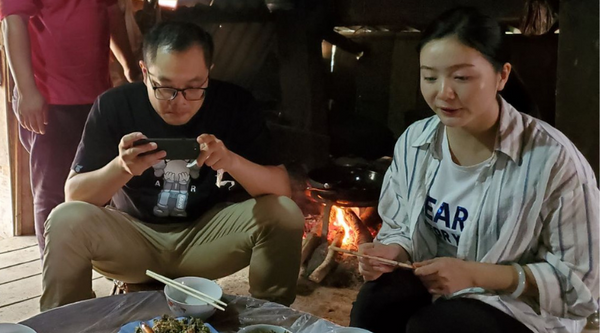
Mr. Soup taking a picture of the soup from Mr. Zhao
Driving in Southern Yunnan also requires time and patience. Since most of the land there is vertical it’s best to be on good terms with those in the car with you. We have been buying tea from Mr. Tang Shuang Jiang for the last two years, but on this trip he was “The Driver.” He is a long-time friend of my friend and travel companion on this trip, Daniel Hong, who said of him “even get lost will not panic” (I had no choice but to be convinced). It would be the first time I’d spent more than a couple hours with Mr. Tang and now we were going to be cooped up together for 10 days. Daniel refers to him by his nickname, “Mr. Soup.”
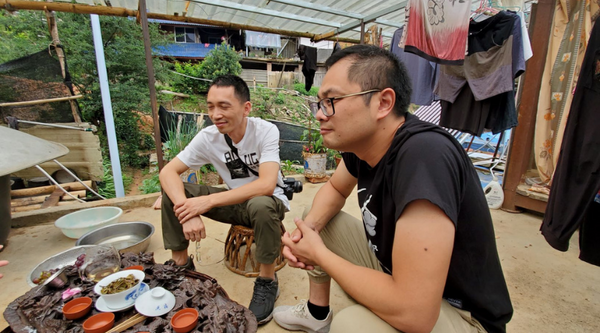
Daniel and Mr. Soup drinking tea at Mr. Zhao’s home
A good driver is always valuable, especially when driving in Xishuangbanna where sometimes the road is only there in spirit. And that spirit is alive with pigs, chickens, slow lumbering trucks of prior eras, cows and their owner on foot, scooters with too many people on them, and us. Driving there requires ever-present awareness since it is mostly scenic and uneventful until it becomes scenic and eventful. This was particularly true when I wasn’t always sure where we were going, and I wasn’t sure they knew where we were going either. True to Daniel’s word, Mr. Tang did not panic.
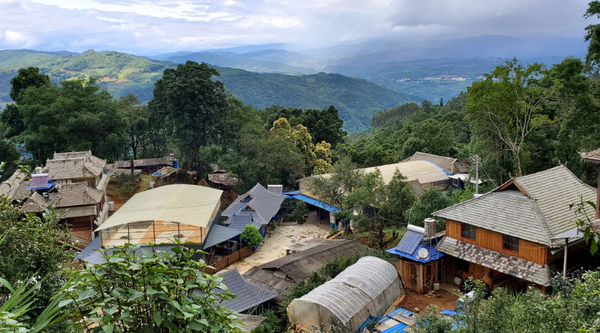
A view from the side of the road in Jing Mai
These long car rides gave me the chance to question Mr. Tang “Socratic-method” style on tea making. Instead of just accepting the direct answer, I had time to ask the naive question “why?” To understate it, the body of information on tea-making printed in English is limiting. He was able to walk me through the thought process on why he chose the specific tea fields, the particular cultivar, and processing decisions along the way to the finished product (and even when a product is ideally considered “finished”).
Check out Golden Buddha & Rock Oolong!
Both of these teas were made by Mr. Tang Shuang Jiang.
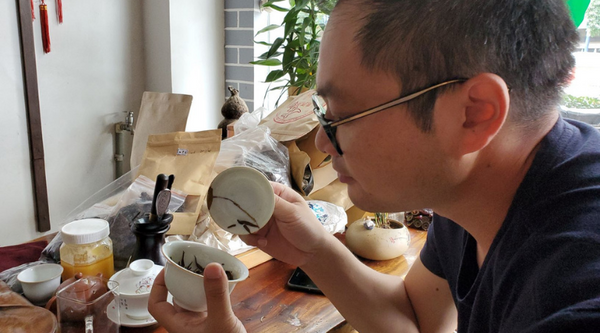
Mr. Tang examining the tea of Mr. Du. This is what you spend most of your time doing.
Mr. Tang’s career in tea came by happenstance. His father sent him to the Fujian tea college after high school. It was free and they were poor. After graduating he got a job roasting oolong at a big tea company, but the politics of a large organization didn’t suit him and he soon quit and found work outside of tea.
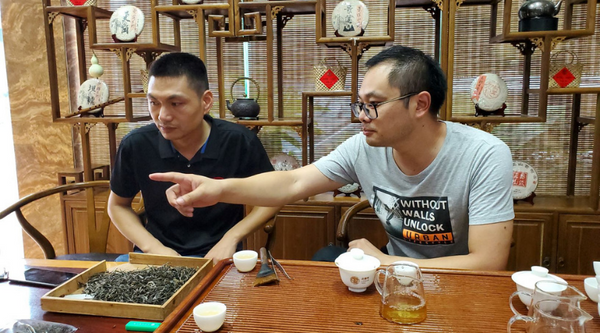
Mr. Tang and his friend Mr. Liu Zhao Qian, Chief Tea Officer of Logan Tea Company
Fast-forward this story, and when asked why he stays with tea, he smiles and says “I don’t know other stuff better than tea.” On this trip we visited Mr. Liu Zhao Qian, Chief Tea Officer of “Logan Tea Company” in Puer city. Why? He was a classmate of Mr. Tang from tea school. We visited Ms. Chen and her husband in Kunming and drank puer collections in the back of ceramic flooring companies (yes, plural). Why? She was a classmate of Mr. Tang from tea school. Most importantly, how did Mr. Tang meet his wife, Ms. Lin Feng Ying? She was a classmate at tea school. Their two-year-old daughter will request a cup of Ti Kwan Yin by name, wait for the cup to cool, then pick it up and drink it.

Mr. Tang and Mr. Chen. We were drinking tea at a tea table in the middle of a ceramic flooring showroom.
In English we tend to talk about tea in myths and legends and not in terms of technique, economics, and daily life - which is actual and fascinating by itself. In the story behind his teas, Mr. Tang is the main character. No monks or monkeys were employed. Just Mr. Soup, time, and patience.
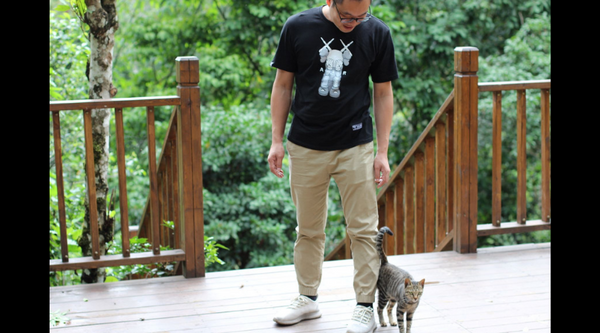
Mr. Soup and his new friend
-Michael Lannier, Operations Manager
-

Ms. Zhao cupping 2017 Bing Dao Sheng Puer – Bing Dao translates as “Iceland”
It’s strange to meet someone for the first time who you’ve talked so much about. The anticipation was heavy since I had come so far and had to enlist the help of others to make this happen. I wanted it to go well.
Shop Ms. Zhao's Teas

Ms. Zhao's store front named Han Ming Xuan, which literally translates to “Elegant Tea Shop”
Ms. Zhao and Mr. Pan’s shop is clustered among many other tea shops (as is Chinese style) in Kunming, Yunnan’s capital city (population 6.6 million). Introductions are always awkward when you don’t speak the language, so to break the ice she offered to cup some sheng puer dragon pearls they made two days ago that were still air drying in front of their shop (air-drying is critical to making puer and is almost never employed in making other teas). The cup is a good model for young, high-quality sheng puer – plum sweetness, a slight pine-like bitterness, a full “oily” body, and a long warm finish that heads straight for your gut. A nice way to set the tone.

Sheng Puer Dragon Pearls made two days ago and still drying outside their shop.
We cupped a dozen more teas over the next two days. That may not sound like a lot, but each tea is steeped as many times as it would yield a quality cup. Some lasted up to an hour. Cupping puer tea tastes like a map of southern Yunnan and Ms. Zhao put numerous teas on the table from places we would visit later; Ban Zhang, Xi Gui, Lin Cang, Menghai, etc. Some of the places I knew of and could point to on a map. Many of them were sub-regions and villages within a well-known area that are difficult to discover without showing up.
Shop Ms. Zhao's Teas

Left: 2019 Xi Gui Sheng Puer – Right: 1988 Sheng Puer
Though she comes from the famous tea town of Chang Ning, Ms. Zhao says she didn’t care about tea growing up. She graduated from school and moved to Kunming looking for work, where she met Mr. Pan. They fell in love, got married, and (as often happens) started thinking about the future. Her sister is in the tea business and suggested this as an opportunity for them. Ms. Zhao claims she has a “slow brain” (her words, not mine – and I don’t believe her for a second), but found the tea business came naturally. She and Mr. Pan opened their own tea shop together, Han Ming Xuan, and have been doing this ever since.

Ms. Zhao and her baby boy, Pan Yi Ming (his twin brother Pan Yi Cheng was not there).
When asked of the future and its challenges, she says it’s the Chinese economy. Since nearly all her customers are in Yunnan and Guangdong, her fortunes will rise and fall with it. But she says she is not an ambitious person and wants to lead a simple life, raise her family, and sell high-quality Yunnan tea - a belief that demand for this timeless product will see them through the ups and downs. TeaSource is their only export.

What tea cupping really looks like. It’s very slow and people come and go. That’s me trying to figure out what’s going on.
I relate to her sentiments about ambitions (or lack thereof). I am just a normal guy from the Midwest who could not be further away from home in every sense of the word. I could easily (and more efficiently) sell tea without coming here. It’s that pursuit of tea itself that brings me here and gives us common ground. Ms. Zhao offered no fluffy answers to my questions, as good as they would look in print. She gave honest assessments of their normal life without exaggeration. The tea itself (the craft, the cup, the business, etc.) is enough for those who love it. I wanted this visit to go well. It could not have gone better.
Shop Ms. Zhao's Teas

The whole crew from left to right: Pan Yi Han (their daughter, 11), Ms. Zhao, Me, Mr. Pan, Daniel Hong, Mr. Tang
-Michael Lannier, Operations Manager
-
Highlights from Michael's tea sourcing trip
Shop the Yunnan Collection
Kunming, Yunnan | Ms. Zhao Yu Jie
Michael's first stop when he arrived in China was Ms. Zhao's family in Kunming, the capital of Yunnan. He spent two days with Ms. Zhao and her husband Mr. Pan touring their warehouse and factory, cupping teas, and discussing future plans. We are thrilled to continue to strengthen our relationship with them.

Ms. Zhao and one of her twin boys
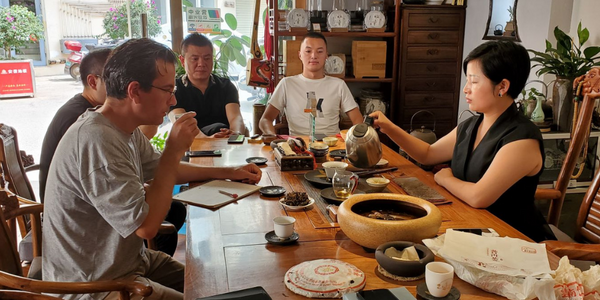
Michael cupping teas at Ms. Zhao's tea shop in Kunming
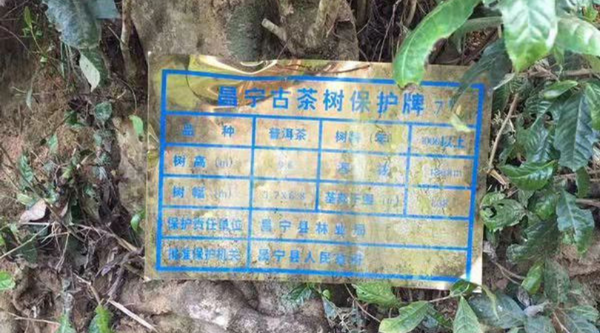
Michael cupped a tea with Ms. Zhao that she made from a 1,000-year-old tea tree. Above is the government sign confirming the tree's age. While we won't be buying any of this tea, it is humbling to think about the history and legacy of those tea leaves.

A view of Ms. Zhao's tea fields and 100-year-old wild tea trees
Puer City, Yunnan | Mr. Liu Zhao Qian

Michael met with Mr. Liu Zhao Qian (left), Mr. Tang's former classmate from tea school. He works at a tea company that makes HUGE quantities of shu puer.
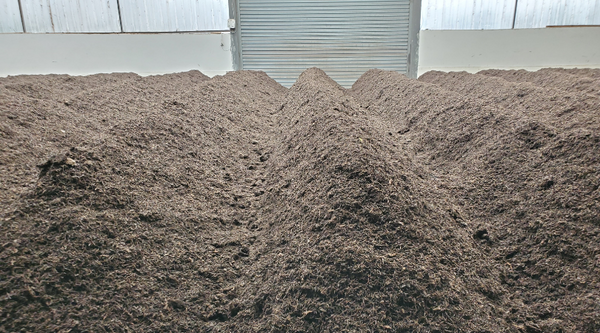
30 tons of shu puer in the final fermentation stage, which is a typical batch size to achieve the desired result.
Jinhong, Yunnan | Ms. Wang Xiyan

Ms. Wang (above) is the business partner of Mr. Yang (maker of our 2018 Yiwu Sheng Puer). Michael visited Ms. Wang's tea shop in the city of Jinhong. She cupped up a 2016 Man Song Sheng Puer, which is from a high demand tea area in Yiwu. Check out her tea table! There's water running through the middle of it with live plants, fish, and dry ice floating over the top!
2018 Yiwu Sheng Puer - Buy it here
Xishuangbanna, Yunnan | Mr. Zhao Tian
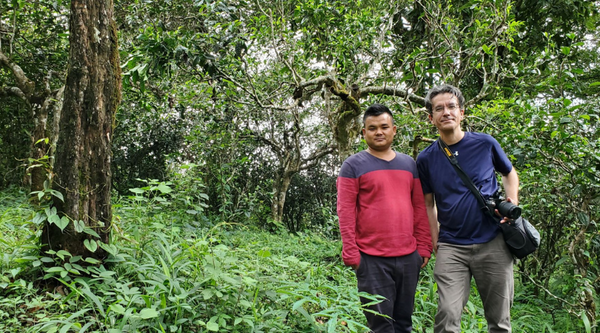
Mr. Zhao (left) is a friend of Ms. Wang. His family's tea fields are on the mountain of Nan Nuo (which is in Menghai), a location whose tea material is in very high demand. He took Michael all over the mountain where they visited an 800-year-old tea tree. He specializes in sheng puer.

Mr. Zhao cooked a six course meal during the visit - the food was awesome according to Michael!Yunnan | The Birthplace of Tea

There's a lot more to say about this trip. And a lot more teas to taste. Stay connected with us here and on social media!
-

The greatest thing about drinking tea in China is that it’s one of the most normal things you can do. You do not need to pretend to be relaxed, mindful, or healthy while drinking it there. It gives me a chance to try to blend in (I don’t) and get the scoop straight from the horse’s mouth. Yunnan Province is said to be the birthplace of tea itself.
Shop the Yunnan Tea Collection

Drinking tea with an instrument maker during my last trip to China, 2018
On this trip (July 1-11) I will be traveling with my friend Daniel Hong and one of our Fujian tea suppliers, Mr. Tang Shuang Jiang. The trip will take us from the capital of Yunnan, Kunming, to Puer City, Lin Cang City, and various stops in Xishuangbanna. The purpose of the trip is to touch base with two of our current suppliers, Ms. Zhao Yu Jie and Puer Tea" rel="noopener noreferrer">Mr. Yang Xiuhai, and have a damn good time. The first hand education of Yunnan’s black and Puer teas is the prize.
Shop Ms. Zhao's Teas

My host and friend, Daniel Hong
There is no more authentic experience than going to a foreign country and trying to figure out what is authentic. Each moment is a subtle test of my wits (which are not quick) since I don’t fully understand the rules of the game (and I’m probably jet-lagged). But it’s that non-quantifiable quality that turns tea from a foodstuff into romanticism. When I realized that most decisions during tea production were made by using the senses (particularly smell) rather than meters and gauges, I decided I did not need to measure out my tea, set a timer for steeping, or worry about water temperature. I just needed to go to Yunnan.
-Michael Lannier

Touring oolong tea" rel="noopener noreferrer">Ms. Huang Yu's tea fields in Fujian, 2018







































